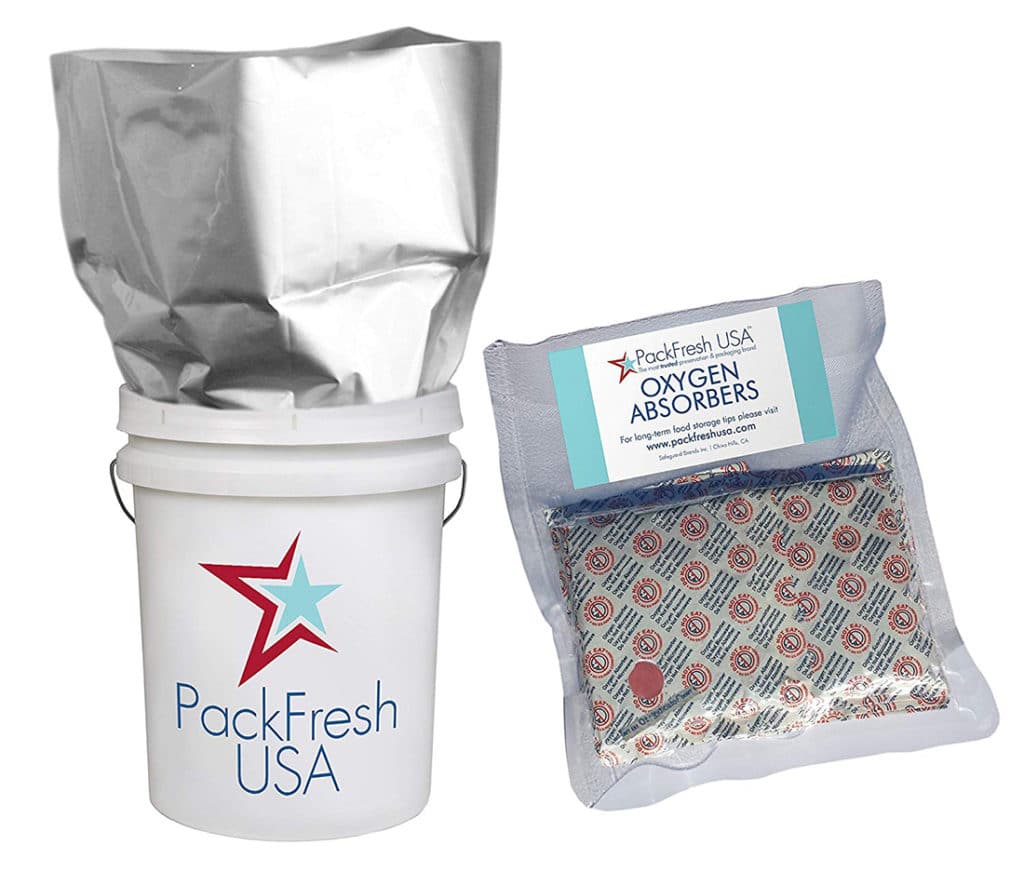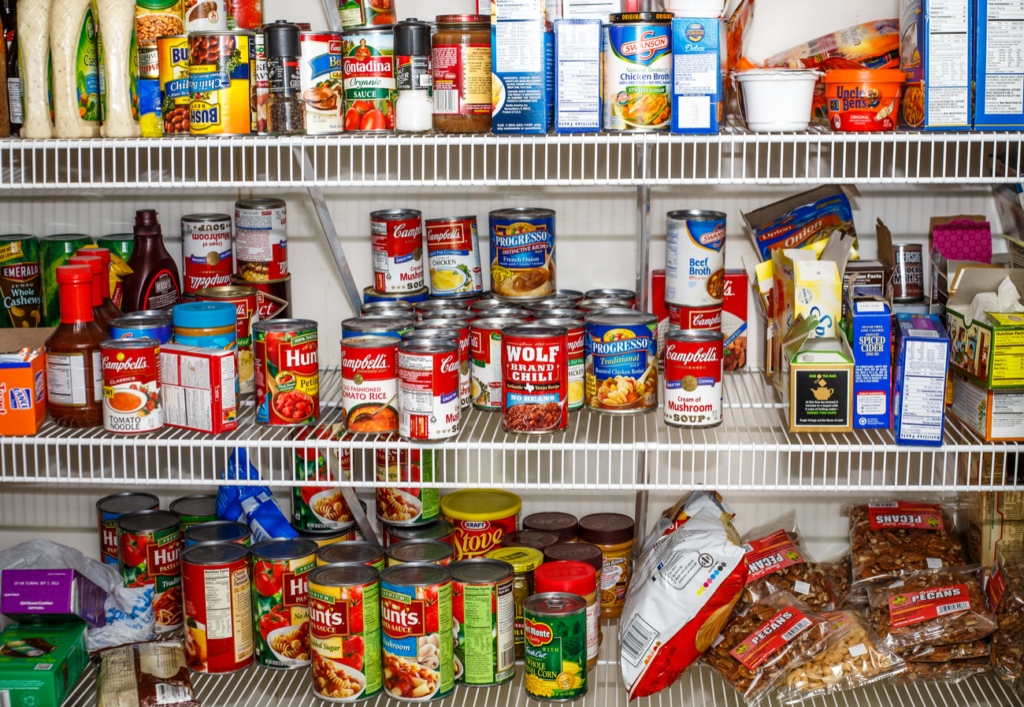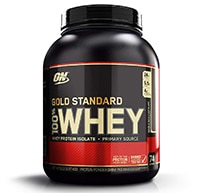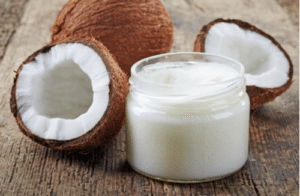Best Prepper Food List and Food Storage Containers

Food is one of human beings’ most fundamental needs. Your body relies on food as its primary source of energy and raw materials. According to the rule of threes, human beings can only survive for about three weeks without food. With that said, you obviously won’t want to go 3 weeks without food, which makes having a well-stocked food supply a key tool in every prepper’s arsenal.
In this guide we’ll tell you everything you need to know about prepper foods, with the goal of empowering you to begin assembling your own prepper food supply for when SHTF.
Table of Contents
- What to Look for in Prepper Foods
- Components of Food - Macro and Micronutrients
- Carbohydrates
- Proteins
- Fats
- Micronutrients
- The Prepper Food Supply List
- Prepper Food Storage
- Where to Buy Prepper Foods
What to Look for in Prepper Foods
When assembling your prepper food supply, you will want to look for foods that have a long shelf life, are calorically dense, are affordable, and are nutritionally valuable. Other important concerns are the amount of cooking foods require (taking into account the cooking methods you will have available in a SHTF scenario) and your own personal tastes.
As for how much food you should store, that is largely dependent on your personal needs, the length of time you would like to be prepared for, and the budget you’re willing to invest in prepping. Pay particular attention to the number of people in your family in order to ensure that you have enough supplies for everyone to eat a balanced diet for a sufficient length of time.
Components of Food - Macro and Micronutrients
Food is primarily made up of three things: carbohydrates, proteins, and fats. These macronutrients (so-called because they are relatively large) each serve different functions in your body. While the optimal distribution between these macronutrients is a subject of intense debate, we will be relying on the Harvard School of Public Health’s “Healthy Eating Plate” model as the basis for our nutritional suggestions.

Carbohydrates
Carbohydrates are one of the most important sources of energy for most animal species, including humans. On a chemical level, carbohydrates are organic compounds that have a hydrogen to oxygen ratio of 2:1—the same as water. Some of the most common carbohydrates include sugars, starches, and fibers.
According to the Harvard School of Public Health, carbohydrates are nutritionally valuable because they “provide the body with glucose, which is converted to energy used to support bodily functions and physical activity.” Healthy carbohydrate foods, which include whole grains, vegetables, and fruits, are also among the best providers of important vitamins and minerals (more on that later).
From a prepping point of view, carbohydrate-dense foods are especially valuable because many of them are relatively easy to store and have long shelf lives. The Healthy Eating Plate model recommends that healthy carbohydrates make up about three-quarters of your total calorie intake per day, meaning carbohydrate-rich foods should make up a sizable portion of your prepper food supply as well.
A note on low-carb diets: Research and anecdotal evidence has shown that low-carb diets, also called ketogenic diets, can be effective for weight loss and overall health. That being said, the majority of mainstream nutrition advice still suggests that carbohydrates should make up the majority of a healthy diet.
Proteins
Proteins are found in almost every part of your body, from your hair, bones and muscles, to your nails, cells and organs. Your body relies on the protein you consume through food to build more complex proteins which perform various functions in your body. Hemoglobin, for example, is a protein that is responsible for carrying oxygen in your blood. On a chemical level, proteins consist of “one or more long chains of amino acid residues”.
If you couldn’t tell already, ensuring that your body receives enough protein is a critical part of a healthy diet—even more-so in a SHTF scenario which will likely put increased demand on your bodily systems. As for what constitutes “enough protein”, the Institute of Medicine suggests that the optimal amount of protein is somewhere between 10-35% of your daily calories. Note that protein and carbs have roughly 4 calories per gram, whereas fat has roughly 9 calories per gram.
The foods that are highest in protein are generally animal products like eggs, dairy, and meat. Protein can also be found in plant sources, particularly seeds, nuts and beans. In general, animal proteins are considered superior to plant proteins because they have a more comprehensive amino acid profile. Unfortunately, animal products are also more challenging to incorporate into your prepper food supply due to their propensity to rot. Rest assured, however, that there are plenty of protein options described in our prepper food list below.
Fats
Fats serve various important functions for human health, including “maintaining healthy skin and hair, insulating body organs against shock, maintaining body temperature, and promoting healthy cell function.” Many micronutrients, including vitamins A, D, E, and K, require the presence of fat molecules in order to be used by your body. These and other characteristics of fat make it a critical component of a healthy diet.
Fats fall into one of three categories: unsaturated fats, saturated fats, and trans fats. The healthiest of these categories is unsaturated fats, which can be found in nuts, seeds, vegetable oils (e.g. olive oil), and fish. Saturated fats are comparatively less healthy than unsaturated fats. Common sources of saturated fats include red meat and dairy products. These fats should be consumed in moderation to maintain optimal health. Finally, trans fats, which are found primarily in processed foods like margarine and shortening, should generally be avoided.
Aside from their nutritional value, fats are also important for the role they play in cooking. Oils are a basic component of nearly every recipe, and could offer some much-needed comfort when SHTF. Fats are also valuable prepper foods because they are very calorically dense; a gram of fat contains about twice as many calories as a gram of protein or carbohydrates, so you’ll definitely want to include some fat-rich foods among your prepper food supply.
Micronutrients
If the only things to consider in assembling a healthy diet were macronutrients, life would be a lot easier. Unfortunately, nutrition is about more than just carbs, protein and fat. Equally important to these macronutrients are the micronutrients, which consist of vitamins, minerals, and other naturally-occurring chemicals found in certain foods.
Micronutrients are critical materials your body uses to maintain optimal health, with each one playing a role in one or more bodily functions. While there are too many vitamins and minerals to go through in detail here, suffice it to say that micronutrient-rich foods are preferred over nutrient-void foods whenever possible. Some of the micronutrients found in certain prepper foods will be outlined in the prepper food supply list.
The Prepper Food Supply List
What follows is a list of the best prepper foods. Included in each list item is a description of the food’s nutritional value, shelf life, and storage requirements.
1) Bulk Dry Goods
Bulk dry goods make up the foundation of every good prepper’s food supply because they possess all four of the key traits outlined above: they have a long shelf life, they’re calorically dense, they’re affordable, and while they aren’t as nutritious as fruits and vegetables, they do contain some important micronutrients.
Bulk dry goods are also excellent prepper foods because they are relatively easy to store. Bulk dry goods should be kept in food-grade buckets (we recommend 5 gallon buckets, but other sizes work as well) with a mylar bucket liner and an oxygen absorber.
We recommend Augason Farms for purchasing bulk dry goods. There products are packaged to last, with most of them having a 20-30+ year shelf life.


Beans
Shelf life: 30 years
Beans should be the foundation of your bulk dry goods supply because they possess a greater nutritional value than other options while still being just as affordable, long lasting, and calorically dense. Beans are particularly valuable because unlike other bulk dry goods, they contain a significant amount of protein in addition to carbohydrates
There are also a wide variety of beans to choose from, each with their own distinct flavor and nutrient profile. Beans can also be cooked and integrated into meals relatively easily, making them ideal for SHTF scenario. While canned beans are an option and will require less preparation, we recommend dried beans due to their superior shelf life.

Shelf life: 30 years
Rice is another staple that belongs in any prepper’s food supply. Where rice really shines is its shelf life, caloric density, and the ease with which it can be incorporated into almost any recipe. As far as nutrient content is concerned, it is worth pointing out that rice is almost entirely made up of carbohydrates and contains less than a third as much protein per serving as beans.

Shelf life: 20 years (Rolled oats), 25 years (Oatmeal)
Oats, either in the form of rolled oats or oatmeal, are another convenient bulk dry food to incorporate into your prepper supply. Oats are filling, nutritious, have a long shelf life, and requires almost no processing other than adding a bit of water. Rolled oats are also valuable in a SHTF scenario because they can be ground down into a flour and used for baking.

Shelf life: 5 years
Dried pastas can be an excellent addition to any prepper’s food supply. Pastas are very carbohydrate-rich and contain little to no fat, which gives them a very long shelf life when stored properly. Pastas do not have particularly strong nutrient profiles, but they are the fundamental ingredient in a wide variety of dishes and can be an excellent treat in a SHTF scenario. One thing to consider with pastas is that they require a significant amount of water and cooking before they are ready to be eaten.
Though typical store bought dried pasta lasts an average of 5 years, Augason Farms' elbow macaroni is stated to last as long as 30 years.

Shelf life: Varies, ~1 year
Other grains such as whole wheat, quinoa, and barley are also valuable prepper foods. The primary shortcoming of grains is their rather limited shelf life. Sealing grains in airtight containers as described at the beginning of this section will go a long way toward maximizing the freshness of your grains.

Shelf life: 1 year
We’ve spent a good amount of time in this guide emphasizing the importance of eating a diet rich in micronutrients, even in a SHTF situation. While dried fruits are comparatively much lower in calories than any of the other bulk dry goods described above, they are a valuable addition to your prepper food supply because they are excellent sources of vitamins and minerals that you may not be able to get anywhere else. Keep in mind that most dried fruits have relatively short shelf lives and should therefore be replaced regularly.
With that said, Augason Farms advertises that their dried fruits are good for up to 20 years, so you're likely better off buying from them.

Shelf life: 1-2 years
Finally, dried meats are a welcome addition to your prepper food supply, as they are one of the most convenient ways to integrate meat into your diet in a SHTF situation.
Jerkies are particularly awesome, as they're packed with complete animal protein and require no preparation. What’s not to like?
For bulk dried meats, Auguson farms offers a variety pack that can last up to 30 years when unopened.
2) Canned Foods and Liquids
Canned foods are likely to be the second-most important food items in your prepper food supply. The primary benefit of canned goods over dry goods is that the majority of canned goods require less processing in order to turn them into a meal. The majority of the items on this list in fact can be eaten immediately after opening the can without any additional cooking. Canned foods are also excellent prepper foods because they are the most convenient ways to integrate meat, fruit, and vegetables into your diet.
The main shortcoming of canned goods is that they tend to have shorter shelf lives compared to dry goods. Consequently, canned goods will only be able to get you so far when SHTF. That being said, they are still an integral part of any prepper’s pantry.

Canned Meats
Shelf life: 5+ years
Canned meats are among your best options for meat products in a SHTF scenario, particularly one in which you have limited access to electricity with which you can power a freezer. As stated earlier in this guide, meat is one of the best sources of protein you can eat, and many meats also contain valuable micronutrients in some amount.
The kind of meat you store is completely up to you. Good options include tuna, chicken, and beef, all of which can be kept safely for over 5 years when stored properly.
Canned Soups/Stews
Shelf life: Varies, 1-6 years
Few things in life can warm the body in as pleasant a way as a nice bowl of soup. Canned soups are an excellent prepper food because they are essentially a readymade meal. Soups can be heated if you have an effective means of heating them, or they can be eaten cold right out of the can.
Make an effort to look for soups that include a mix of vegetables and meats. This will maximize your nutrient intake. Also be sure to note the expiration dates when choosing your canned goods, because some products last significantly longer than others.
Canned Vegetables
Shelf life: Varies, 1-5 years
While canned vegetables are unlikely to win over many fans with their taste alone, vegetables make up a critical component of every healthy diet and are therefore worth including in your prepper food supplies. Try to select a variety of vegetables of different colors. The different colors are generally good indicators of different micronutrients found within.
Vegetables alone are very low calorie, meaning vegetables should primarily be used as nutritional supplements to more calorie-dense foods.
Canned Fruits
Shelf life: 1-2 years after date on can
Canned fruits are an attractive prepper food because they are nutrient rich and can also be delicious. Along with canned vegetables, canned fruits will likely be one of your primary sources of important vitamins and minerals. Worth drawing particular attention to is vitamin C, because deficiencies will lead to scurvy. You’ll do well to stock a variety of different fruits just as you did with vegetables.
Stocks and Broths
Shelf life: 1-2 years past printed date
Canned stocks and broths can be a valuable addition to your prepper food supply. These flavored liquids can be very useful in cooking and can help turn a bland meal of canned chicken and rice into a flavorful meal.
3) Beverages
Most bottled beverages other than water (see our water storage and filtration guide here) have relatively short shelf lives and are therefore not especially useful in a prepping situation. However, powdered beverages that can be mixed with water are an excellent addition to your prepper stockpile. These beverages can be sources of comfort, energy, and even nutrients.
Whey Protein Powder
Shelf life: 2-3 years
Whey protein powders are one of the most convenient protein sources to include in your prepper food supply. Simply pour a scoop into a cup of water, stir it up, and you’ve got yourself a high-protein treat. There are countless protein powders available nowadays, but there’s no need to overthink the decision. Simply choose one that is economical and well-reviewed.
Sports Drinks
Shelf life: 1-2 years
Powdered sports drinks including Gatorade and Powerade are excellent additions to your prepper pantry. They taste delicious, are easy to mix with water, and are valuable sources of electrolytes your body needs to stay hydrated.
Tea/Coffee
Shelf life: 2-20 years
Tea and coffee are great sources of both caffeine and comfort. They’re easy to store, have long shelf lives, and are often delicious—a real no brainer. We recommend using instant coffees as these are freeze dried and have extraordinarily long shelf lives.
Powdered Milk
Shelf life: 2-10 years after printed date
Milk is a great source of calcium, protein, and other nutrients, which makes dry milk a welcome addition to any prepper’s food supply. Powdered milk can also be used in baking, which might be nice on special occasions in a SHTF situation.
4) Oils
Storing oils can be tricky, as the majority of vegetable oils can turn rancid very quickly. As with many other items on the food list, oils should be replaced regularly in order to ensure that your supply is still good.
Coconut Oil
Shelf life: 1-2 years
Coconut oil is an excellent oil to include in your prepper food supplies because it has a longer than average shelf life for fats, is delicious, and contains a variety of micronutrients. Coconut oil also has many additional uses beyond eating: it’s good for your hair and skin too!
Olive Oil
Shelf life: 1-2 years
Olive oil is another excellent choice for a cooking oil. It is not as nutritionally valuable as coconut oil, but it is a welcome addition due to its familiar taste and use in many recipes.
5) Nut Butters
Arguably an even better source of fat than oils, nut butters are another staple prepper food. The primary advantage that nuts have over oils is that while oils are made up entirely of fats and have almost no micronutrients, nuts also contain protein and a variety of vitamins and minerals. The primary shortcoming of nut butters is that they have short shelf lives compared to many other prepper foods and require regular replacement.
Peanut Butter
Shelf life: Up to 1 year
A favorite of both kids and adults alike, peanut butter is a classic prepper food. Incorporate it into a meal or eat it by the spoonful; peanut butter contains good amounts of protein, healthy fats, and vitamins E, B3, and B6—among others.
Almond Butter
Shelf life: Up to 1 year
Although almond butter is not as popular as peanut butter, it’s another excellent addition to your prepper food supply. Almond butter boasts many of the same good qualities as peanut butter, but has a slightly different flavor and nutrient profile.
6) Miscellaneous Food Items
Herbs and Spices
Shelf life: Varies, “fresh” for 1-4 years, “good” for longer
In addition to being a source of fuel and nutrients, food is also one of life’s great pleasures. Incorporating a wide variety of herbs and spices into your prepper supplies will allow you to turn bland, unexciting foods into inviting meals. Many herbs and spices also have medicinal uses, making them a truly invaluable addition to your prepper pantry.
Special emphasis should be placed on salt, which is also an excellent means of preserving raw meat. For this, along with salt’s other uses, a large supply of salt should be a permanent feature of your prepper food supplies.
Honey
Shelf life: Indefinite
Honey is the only naturally-occuring food on earth that never spoils. It will crystalize over time, losing its clear color and transitioning to something a little murkier and grittier, but it will always be edible. This unique property aside, honey is a great addition to your food supplies because it is delicious and can pep up a wide variety of meals, including oatmeals. Honey also possesses natural antibiotic qualities and can be used on cuts and wounds to prevent infection.
Sugar
Shelf life: Indefinite
Much like honey, sugar comes with a wide variety of uses and will also never spoil. A large supply of sugar is therefore a welcome addition to your food supplies.
Hard Liquor
Shelf life: Indefinite
I don't know about you, but personally I think some alcohol may help ease the pain of a SHTF scenario. For those of you on the same page as me, stick to hard liquor, as it does not require refrigeration and can stay good indefinitely when unopened.
Frozen Meat
While most readers are unlikely to have a means of keeping a freezer running during a SHTF scenario, for those readers who do have a backup generator, solar panels, or some other means of ensuring a freezer can remain functional, frozen meat is an excellent addition to your prepper food supply. If not planning to hunt your own meat, we recommend buying your frozen meat in bulk from Butcher Box.

Prepper Food Storage
The most important factor with regard to storing your prepper food supply is to keep it in a cool, dark, dry place. Basements and cool garages can be good locations, otherwise closets and pantries might be your best bet.
Beyond these fundamentals, proper food storage will depend on the item you are storing. Dried goods should be kept in food-grade buckets lined with a mylar bag and at least one oxygen absorber. Sugar, seeds, and herbs/spices will benefit from being stored in the same way.
Canned foods do not require any additional storage measures beyond the can; just be sure that the cans you purchase don’t have any dents, which can lead to spoilage.
